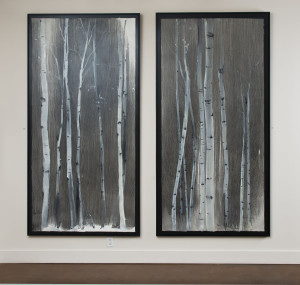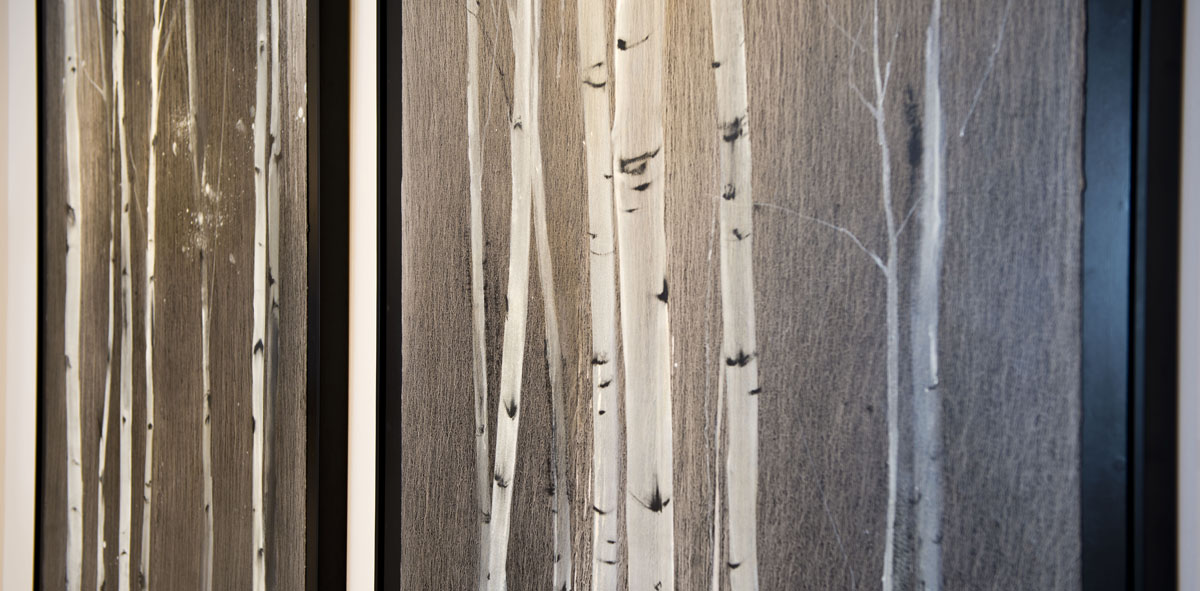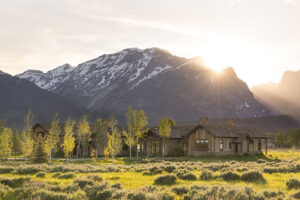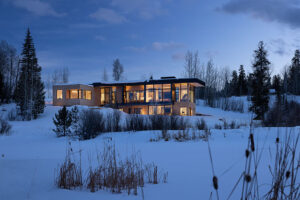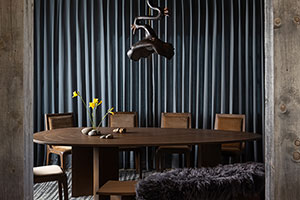In this new series on the Homestead blog, we sit back and let Jackson Hole’s creative professionals become the storytellers. Each One Work blog entry is focused on the genesis, production, and meaning behind one significant local piece. During our conversations with artists, designers, and other creatives, we invite you to learn more about craftsmanship and the artistic process. Discover what it takes to make One Work.
Walk into the Trio Fine Art gallery and there they are: two towering, silvery canvases dominating an entire slender wall. The paired aspens paintings, Cathedral 1 & Cathedral 2, stop one right in one’s tracks.“Are they meant to be a pair?”
Apparently, Kathryn Mapes Turner gets this question a lot. We’re in the gallery she co-owns with Jennifer L. Hoffman and Bill Sawczuk, and as she relays the story of how these two stunning works moved from concept to finished paintings, we sip tea and stare upwards, focused in on the flecks of ghostly paint.
Each painting has been composed on the monumental scale of 4×8 feet, and although, in fact, they do not have to be sold as a diptych, their effect together certainly adds to the drama of the wall.
Turner mainly paints plein air canvases and field studies, which necessarily call for a smaller space capable of recording the transitory impressions of nature. She notes that working from her studio allows for more interpretation and the ability to change the scale—in this case, to a soaring eight feet.
In a fashion, Cathedrals 1 & 2 follow a progression of working styles for Turner, who is a life-long painter and local—she grew up on the Triangle X Ranch, one of the oldest continuously operating ranches in Jackson Hole. She herself began with watercolors, which she says “taught [her] the aspect of spontaneity.” In the delicate interplay between water and the tincture of pigment, skill and happy accident find the ideal marriage.
“It’s almost a dance you have with the paint.”
As Turner transitioned to working in oil paints and the larger window of work time they allowed, a premium paper company called Arches began producing a new paper on a large scale. Struck by the notion of combining two separate yet equally rewarding painting approaches, Turner’s thoughts turned to a large canvas, the largest she’d ever painted. She decided to approach this oil painting more like a watercolor, and yet still painting in oil, she’d have more time to experiment. Oil is also the longer-wearing medium, allowing the dual canvases to take shape through a combination of ephemeral brushstrokes and more lasting swirls.
Looking closely at the canvas, one immediately notices its uniquely textured backdrop and almost charcoal metallic hue. This texture came about from embracing just a little bit of chaos. First, Turner mixed up big buckets of paint with heavy doses of water. At this point, she allowed the paint to drip down the entire length of both canvases. As the force of gravity pulled the paint downwards, the pigments of the paint separated and reacted with the watery solvent. “The fun happens when you let the paint do its thing,” Turner says. It’s a sense of adventure and “wait and see” that she brought to the entire project.
What led to the unique titles of Cathedrals 1 & 2? “When I’m in an aspen grove, I feel like I’m in a cathedral. I was driven to do something that would have that same feeling.” The subject also dictated the height of the dual pieces. Aspens are Turner’s favorite trees, and their vertical elegance was a feeling she wanted to duplicate in the impact of her paintings. “I wanted to make them more tree-like.”
The constellations and disturbance of the paint splotches one can observe when up- close-and-personal with the canvases also came about from allowing the paint to drip. While she painted the Cathedrals, Turner had both canvases laid out flat on the floor. A little dripping was inevitable, and quite beautiful.
“Process is what teaches us what we need to know,” Turner says.
In terms of process, the framing of Cathedrals 1 & 2 proved the trickiest and most demanding aspect of the creation. The stark black float frames are sold with the pieces, and are designed so that the edges do not obscure any part of the actual painting. These visibly rough and torn edges add even more delightful texture and visual interest to the two ethereal paintings. Attaching the long, thin canvases to the backboard meant dabbling in permanent glue, so there was quite literally only one chance to get the alignment right. With a team of friends and a lot of research, Turner attempted—and succeeded—in the difficult framing.
It was all worth it, too, as the lack of glass dispels any separation between the paintings and the viewer. As Turner knows, these are the sort of works that beg to be scrutinized; often viewers even put out a tentative hand to touch them, catching themselves and stopping before going any further.
She’s glad of the varying reactions and inquiries she’s received regarding the paintings so far, explaining that, “when art inspires different reactions it makes it more compelling.”
As for Turner, she knows these two singular paintings are something that can’t be replicated—not by look or feel or the many serendipitous experiments that led to their completion. For everyone who sees them, whether once or repeatedly, they are pieces with their own place in time, history, and experience. Landscape painters know well the ineffable and mutable subject that endlessly fascinates them.
“I could never do this again,” Turner laughs. “That’s what art is.”
Visit Cathedrals 1 & 2 yourself during the upcoming View 22 event hosted by Trio Fine Art on Dec. 6 from 5-8pm. You can also contact Kathryn Mapes Turner at kathryn@turnerfineart.com and view samples of her other work at Turner Fine Art.


